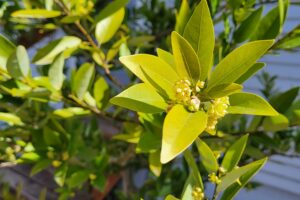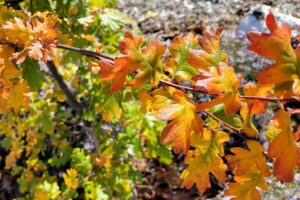Tag: horticulture
Sourcing Trees for a Changing Eugene

What trees should we be planting in a changing climate? That question has been top of mind for the Friends of Trees Eugene Branch for a long time.
“I remember saying, ‘in 50 years, Eugene will be like Sacramento.’” says Eugene Director Erik Burke. “Well, I started saying that thirty years ago, and based on what we’ve seen, it’s not far off. We’ve ‘moved’ rapidly south in terms of what our climate is like, and the pace is picking up.”
The Eugene Branch has been planning accordingly. For the past decade, they have been sourcing and planting appropriately resilient trees in anticipation of the changing climate. “We have been planting native live oaks and other species for ten years now and are learning a lot.”
“We started with locally available trees that are drought tolerant and heat resilient, like Oregon white oak and silver linden.” Erik continues. “Then we asked the question, what trees are available in the nursery trade between here and Sacramento and what trees thrive in northern California cities? We began trialing California native oaks, crepe myrtle, Persian ironwood, chitalpa, and many other species that at that time were less common in the local nursery trade.”
Where do we get our trees? It’s a question we take very seriously. We source our trees from trusted nurseries that provide reliable stock. We are limited to some extent by what is available at nurseries, and that has a lot to do with consumer demand. So it’s no surprise that planning for a future urban forest can get a little tricky when it comes to getting the actual trees, especially with our commitment to an ethos of right tree, right place.
Historically, many consumers have been motivated in their tree choices by aesthetics and comfort–they want trees that remind them of where they came from. Fortunately, we are seeing an increasing consumer demand for natives and climate resilient trees. The Eugene team is working with local nurseries that will take seeds or liners (baby trees) and grow them out to planting size. They are also growing out many of these trees themselves.
“Some nurseries are open to growing climate resilient trees,” Erik says. A great success story is Oregon white oak, which only recently has become a profitable part of the nursery trade. “During my time working on trees in Eugene,” Erik says, “we’ve seen Oregon white oak go from a little used tree to one of the most common street trees we plant each year.”

It gets more difficult when it comes to the California trees, which the Eugene chapter initially began importing because they were not readily available in Oregon. “Shipping trees up from California risks importing a pest or disease and burns more diesel,” Erik says. “So we are partnering with nurseries to grow seeds and liners from California species here, and growing them ourselves.” The Eugene team is also exploring new additions from other summer-drought regions of the world with similar climates, like the Mediterranean, but these trees need to be run through a filter for potential invasiveness.
To open up their options, Erik has started growing trees himself. “It’s a huge learning challenge,” Erik says. “There’s a lot to learn about horticulture.” He started with a few trees in his yard, but he has learned enough to lease land to expand the operation. “I’ve got a 440’ row of seeds and about 500 seedlings and 350 containers planted at a nursery this season and will expand substantially next year.”
Some of the species he’s excited about growing are: blue oak, California black oak, valley oak, canyon live oak, Oregon myrtle, madrone, Isla, toyon, chinquapin, and many more.
By selecting trees for their resilience and for the benefits that they can provide, Erik hopes that people can move their preferences away from pure aesthetic value and appreciate trees for their benefits to nature, functionality, and what he calls, “a beauty related to their fittingness in the landscape.”
Urban foresters meet online, study

Oregon State University is offering an online urban forestry course for this upcoming fall term. The class is cross listed within the College of Forestry and Department of Horticulture.
The one sentence course thesis is as follows:
-Introduction to principles and practices of planting and managing trees as a system of urban environment; understanding the economic, environmental, social aspects of urban forests, and an overview of contemporary land use issues and societal perspectives between people and plants.-
Register or read the syllabus for the three-credit course online.
–TS
